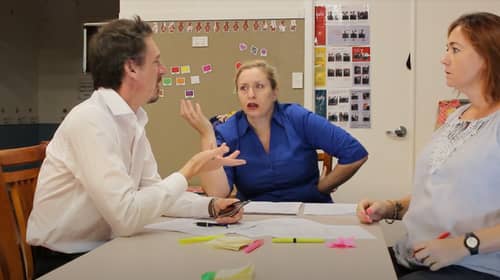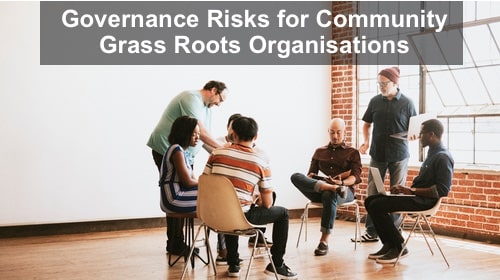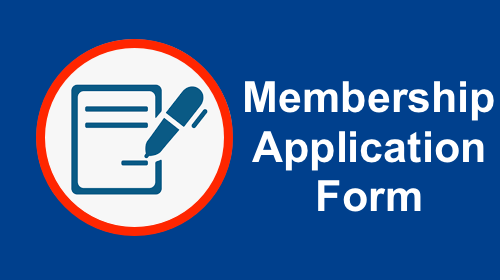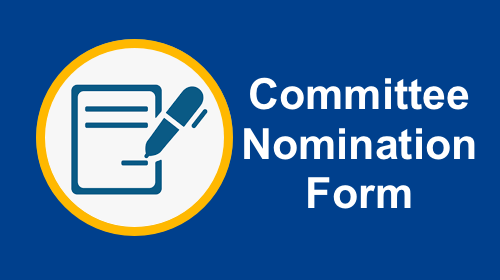How to run your AGM
Watch our experts Natalie Bramble and Andrew Wright explain how to run a smooth and legally compliant AGM.
Authored by: iClick2Learn Team
Translate Text
– So preparing for the AGM looking at the rules both your rules and the model rules. setting an agenda for the AGM dealing with resolutions reports what types of reports holding elections voting both for Resolutions and elections. This is a nice one managing difficult situations post AGM. And then we’ll allow a bit of time for Q&A at the Finish. So let’s look at preparing for the AGM and I thought it’s it’s interesting. What I normally do is to work my way backwards. And my AGM earlier this year was due to be by the end of May five months after the end of the financial year. So we had a calendar year five. Sorry Financial year. So I gave the order to recall in mid January and said okay, let’s start the process. So I think it’s really helpful to say, okay, if you’re if you’re at the end of May or the end of June or wherever it is, if you work your way backwards, make sure to give yourself enough time to cover off all the bases. So there’s lots of questions and plenty of things to get right.
– First of all, of course is when do you need to hold your AGM and if you’re a new organisation? That’s within 18 months of formation and depending on the state you’re in. It’s either five or for an existing organisation. It’s either five or as I found out this morning within six months of your age. Sorry the end of your financial year if you’re in wa so just check that that’s in your incorporations Act. For whichever State you’re in and you can get those quite easily just by Googling. So look at the regulations. Then set yourself. A date and a venue that suits the people who you want to attend and do you need catering? You know all those sorts of things. What’s the format going to be? I just pop this one in this morning, you know dress code. Do you expect people to turn up, you know board members and and if executive or staff turn up, you know, are they going to be wearing shirt and ties or is it casual? I think that’s good to set those expectations early rather than for example, you know most of your board members turn up quite well-dressed and one board member turns up and feels horrible because they’re in a pair of short songs and a t-shirt or something like that and that’s unlikely to happen, but maybe in Tennant Creek, maybe it would Do you need to check anything in your Constitution, you know things about elections reelections proxy voting casual vacancies all those sorts of Clauses. Are there any of those? That you need to review any Clauses that you need to review and perhaps some of the content we’ll look at today might get you to go back and have a look at your Constitution because there’s a few Clauses in there. Often that I reckon don’t work. So, you know, maybe that’s something to look at and and technically you’re supposed to do constitutional changes at a special general meeting. And if you really want to you can hold the special general meeting just before the AGM do them on the same night with the same people there. Do you want speakers there, you know a guest speaker and if so often a really good idea. Because to be quiet on us. And your general meetings can be quite boring at times if they’re not well since you want and who’s going to do those and you know, here we go, you know, do we need audited financials and depending on the size of the organisation?
– Yes, you do or no, you don’t you can check that on the ACA and see website to check if you do need audited financials, and if you do then you need to talk to the auditor. Um, do you need to replace the order to orders as normally come in on a three-year term and if the terms up, you know, hopefully you’ve thought about that already and you’re on top of that in terms of putting out an expression of Interest or Tender or whatever the process is for you to get a new tender a newer existing tender. You’ll need the last agenda minutes and my recommendation would be that as soon as the AGM has held that you get someone to write up the minutes and get them approved. You don’t want to be going back 11 months later trying to find someone’s. Scrolled notes about what happened 11 months ago and get them all done. Are you going to prepare an annual report? What’s it going to look like? What’s the budget you know, is it going to be bells and whistles or is it going to be? You know something printed off the the printer at work with a couple of pictures. How’s it going to be prepared? Who’s going to do the reports? What outcomes do you want to show in the annual report?
– Then you want invitations for members and guests. Do you have an up-to-date members list? And my last name my my last email that I sent out earlier this year. I picked up last year’s members list only to find out that most of the emails were redundant or incorrect. So, you know probably half the members on that list didn’t get notification and that caused, you know a couple of questions and rightly. So so, you know, make sure that you do that if you’ve got guests. um, or you want to have guests there special guest ministers local MPs Council Guest speakers, you know make sure that you give them plenty of time to get organised as well. Then of course you you want to have a board like if you’re right and she’s so cool to nominate. Do you you know, do you have any particular people you want to Target? Have you done a skills Gap analysis for the board and identified any any particular skill needs that you want to go and Target. This one’s an interesting one I think to and also check that the procedures that your AGM are consistent with your organisational values and an example of that I would use is that if one of your organisational values that you trumpet regularly and withhold diligently is open and transparent and honest and an open and all of that. You don’t want to be in the position where you need to shut someone down at the AGM because that’s sort of flying in the face your values. So that’s that will come up in the difficult managing difficult situations.
– So there’s a lot to think about but I think that process of working backwards, you know, if it’s at the end of my the end of June then start the process, you know, maybe even six months months out five months out from that and give yourself plenty of time to get organised. I’m doing to hold that an AGM if our members are our committee or board. What do you think? on that question Yes, correct. So you’re the only one I can see so I’ll take your answer. Yeah, you’re right. You still need to anyway, you need to have an annual general meeting as an incorporated Association or a company limited by guarantee. Are you going to hold the meeting in person or virtual? Oh good to be. Or combination of both and if it’s either but particularly both you need to consider that the setup because if face to face and you’ve got some people on Zoom one of the big considerations is how you make people up. It’s okay to be talking on zoom into it, you know into a television or a set of speakers or monitor, but if you’ve got people live around a table or in an audience speaking the people on Zoom aren’t going to hear it. Who needs to be there? And who do you want to be there? Would you include staff? In the invitation if you have staff. I got asked earlier back earlier in the year, but a couple of by a couple of Staff, you know, should we attend and I said look, it’s procedural. They’re not particularly interesting if you want to come along feel free, but to be quite honest, I’m happy not to have staff there. But if they want to come along again, you know that that’s fine. And how do you get those people there? And and you know had he going back to the date and venue. How do you get the right date to make sure that you get the right people there and the right time do you hold it during the day at 12:30? Which means people who are working generally can’t get there. What do you hold it at night which means people particularly with young families or other commitments might not be able to get there and that’s a bit of a challenge juggling act and maybe maybe change around.
– Here on and year on to you know to to give a couple of options options. Another thing you can do is to ask for questions and speakers obviously because to talk about but but you know so that you’ve got an opportunity to coordinate a response and you’re not caught. Short on the night which can be, you know a bit stress inducing I guess. Develop a protocol for speaking for example. Everyone you muted using raised hands or remote cons to get attention. I was just saying to Glen before today’s session. I find it difficult. When I’m presenting to be keeping my eye and the chat box and the recording it as I’ve already done, you know, I I tend to just be focused on what I’m doing. So too many things if you presenting is is a bit of a challenge. Maybe have a separate breakout room for voting members to use for voting decisions or put non-voters back into a waiting room. And that’s just another suggestion about how you manage that. Um, iClick2Learn scott some resources in there that you might want to take a note of and again, this will all be included in the the recorded version for you to access later meetings via technology and attracting new committee members. So anyway, when you’re in the meeting part of the preparation for that is to determine how to track attendance and that can be a little trickier. I suppose on Zoom. Although if you’re recording it you’ve at least got a record of who was there.
– If determine how to identify voting rights some constitutions. Have voting members and non-voting members, and of course you’ll have visitors. so you need to be able to I guess identify who can actually vote. One of the one of the ones I think that is interesting is do you have an executive officer or see? ability to vote to be a voting member. I don’t know. Maybe I’ll open that up for For suggestions from you you what what’s your position on that? Do you think? I know there’s a couple of groups here where staff are members of the organisation. Yeah, but they’re not allowed to vote and that’s written into their constitution. Yep. Yep. Yeah. Yeah, and I it’s that’s a that’s probably pretty good way to do it. I I think it’s good to to encourage staff involvement. Obviously at that level of the organisation. I guess my view is that if If you’ve got staff voting and you’ve got quite a few staff members, they could probably control the vote, which is not necessarily A. Good thing I reckon okay. Let’s keep moving on updating. The members register. I’ve already picked that and when’s the last date prior to the AGM that you’ll accept new members. Remembering that you need to approve and ratify them pre-AGM for them to be able to vote. So that’s another thing to work your way backwards on. And probably your last. Date for that previous pre-AGM would be the board meeting prior. to the AGM How can you make the AGM more interesting and enjoyable? What a great question the last one I went to and look admittedly. It was a small local. Group, I got invited to come along and observe. We got into the reports and the chairperson sat down and read out three top pages.
– Of probably not all that interesting information followed by the treasurer’s report, which was a printout. of the day’s that days Bank balances as opposed to The end Financial year position. So the lack of probably didn’t matter so much at that level. But but in terms of reading out a three-page report whilst not engaging at all with your audience wasn’t particularly good so Um, I think that’s a really good thing and maybe to put to your board in planning for the AGMs. You know, how do you get some engagement? You know, do you do a bit of Q&A? What are some of the costs or what are some of the risks in doing that? You don’t want to open Pandora’s boss box, but the benefits could be could be amazing, you know, do you do some workshopping or do you have a guest speaker or you know do you put on catering as I mentioned before? What’s the committee board nomination process and what what are all the dates and timelines behind that and what if what do you do if you don’t have enough nominations? For vacant board positions. These are all things to to consider. I would resist very much. Postponing the AGM if you’ve already put out notice for it and maybe you you know if there are board members. Who are not continuing but a willing to to hang in there until you get a couple of new positions filled that that’s probably a pretty good? perspective I think to take again some resources from iClick2Learn the committee nomination form and the I can’t even see that membership application form. Are there for you as well?
– So if you go and check the model rules, whichever State you’re in here some examples. When do you need hold the AGM as I said within 18 months of incorporation or thereafter within five months or six months in WA there we are. What notice is required? subject to Clause 8 3B at least 14 days of any general meeting should be given um notice of them making at which a special resolution is to be proposed either at the AGM or special general meeting. You need to give 21 days notice and you need to publish and circulate obviously what the resolutions are so that people got time to consider their position. You’re also find some advice about quorums. It says he procedures a general meetings 10 members generally present personally, I or by proxy. But it does note under that a lesser or greater number may be appropriate depending on the size of the membership so we can’t have ten members. there as a quorum if you’ve only got You know eight members in the organisation. So obviously go back and check your Constitution and that is a clause I reckon. That’s worth considering you know, what is an effective Quorum. What’s an effective maximum membership. Does it matter? The more members you have the more members you have to service and keep in contact with if you’ve got a hundred members.
– And your Quorum is 50% plus one, which is not unusual. That’s 51 members. Can you get 51 members? either in in personal by proxy to attend your AGM if you can’t you can’t have the Properly constituted AGM, so just need to think around those sorts of things. If there’s no core and what’s the alternative? any thoughts on that if you if you Turn up to a meeting. You don’t have a quorum. I’ve attended a couple of AGMs where we haven’t had the Quorum. Yeah, I’ve been postponed seven days saying location same time. Yep, and you’ve done the massive ring around and say we just literally need you to turn up for 10 minutes. Yeah. There’s nothing exciting. We just everyone’s very standing. Yeah, but yeah, it’s doing that massive ring around in the week in between. Yeah. Yeah. Thanks Nick Nicholas. Sorry. I’m Sue. No, that’s okay. I was just had a question there. You’ve got procedure of General meetings. Is it the same for AGMs? Yeah, General meetings and annual general meeting or a special gender meeting yet. Okay. That’s all that’s what we’re referring to here. What Nicholas said is correct? You you can defer the meeting same time location. So same place and location. Seven days. Later. I think probably the way to get through that is to make sure that you’ve got a quorum before you get to the AGM and that’s maybe easier said than done. But you know do the ring around before the AGM and if people aren’t going to be there then use your proxy voting capabilities if you’ve got that within your Constitution because it’s no fun to turn up, you know all ready to go and you’ve got a postpone to seven days later.
– So if you can get that organised beforehand, I think that’s a really good trigger point. I believe the New South Wales model rules don’t allow for proxies now. Oh, okay electronic. Let’s check that. Yeah. Yeah, I believe you can be there electronically or in person but I believe proxies have actually been taken out. Oh, okay. Thanks. I’ll check up on that. And we’ll get some clarification back to to everybody on that, too. Okay. How’s voting managed? Subject to these rules every member of the association has only one vote. Voting is an interesting one. It’s easier. If you’re doing it in person a little bit more difficult if you’re doing it in zoom and the way to do it, I think via Zoom is to have An online voting capability set up so that people can log in or just click in and cast their votes. That way what’s your own experience with with voting via Zoom? Have you done that? yourselves not Okay, that that’s some. I haven’t done that myself Nicholas. Sorry. Yeah, mine do the entire meeting was via Zoom. Yep. So none of us were in the same room together. It was literally the same as the physical one all those in favor and we held our hands up until the secretary counted them. And then another group we’ve done it use the reactions and put raise your hand there. Yep, and then they just that was recorded somehow in zone. I don’t know how they actually did that, but Okay, thank you. That’s that’s also something. I think we should should be able to clarify some options there I think too. And of course, the other thing there that we mentioned earlier is making sure that the people who are voting reps actually eligible to vote. What about proxy voting or Nicholas has said the New South Wales, you know not able to do property voting now and you’re saying I think that you can do electronic voting so you can yeah, you say Nicholas you can you can but sorry log in and do the vote that way. Yeah. So I’ve just downloaded the model Constitution from Fair trading yourself Wales and section 346 says a member cannot cast a vote by proxy.
– So it’s been taking that right to being taken out of the model rules here in New South Wales. Yeah. Uh, okay. Yeah, and that’s interesting big because proxies are good. But they can cause problems about proxy voting is that it should be limited to one proxy vote per person. Otherwise, you’ve got the potential of one member going and getting 30 proxy votes and turning up to the AGM and they can vote. Anyway, they like and I’ll probably win the vote. Um, so you it probably thinking, you know, you look at that and you think that’s a negative way of looking at things but it’s actually risk management you want to look at what can go wrong with this picture and then try and you know manage manage that risk as as best. You can before you get there on the on the occasion. So if you have proxy votes that that is a really good way to handle it or the online voting system as in New South Wales that that’s really great too because you can then make sure that you’ve garnered enough floats before the AGM to to have sufficient votes and sufficient numbers to you know to be able to move forward with business. Okay. So making sure that the purpose the AGM is is to cover it off and the order of business is outlined here confirmation of minutes for the previous AGM and any sgm health intercept meeting election of committee members appointment of auditors. If the auditories is appointed on a three-year term in your halfway through that it’s just confirmation of the auditor rather than appointment of the auditor. consideration of the accounts and reports of the committee and the Auditors report the the AGM that I was that recently failed to mention that the Auditors report was a qualified Auditors report. To which I thought was a bit of an oversight to.
– So you need to be again quite open and transparent about all of those sorts of things and any other business requiring consideration by the Association Ruth had a question about deciding whether something needs to be voted on at the AGM or can be dealt with at a committee meeting. I think the the probably the broad answer to that Ruth would be that if it is in it if it is a matter that requires General consideration or formal vote by the broad membership, then you would take that to the AGM or the special general meeting rather than just confining it to the board. So and there’s probably a whole range of things there. And if you look at the the model rules all your own Constitution that might help you to determine that a bit more clearly. um special resolutions I was looking this morning at the incorporations Act so the the special resolutions can be proposed. And depending on what the resolution covers it’s either at an annual general meeting which is you know, a general vote. Um on maybe general direction of the organisation or a particular proposal if you want to take that to the members picking up Bruce Point and special special General meetings, for example, constitutional changes or primary organisational changes. Okay, which thanks for that answer. So again, check your Constitution and how special resolutions are checked there. Some organisations make them mistake of taking constitutional changes to AGMs. Whereas it should be a special general meeting. Look at the end of the day. Is anyone going to put their hand up and be concerned about that? Possibly not probably not but you just don’t want people, you know finding reasons to to stir things up unnecessarily because if nothing else it’s just a waste of time. Nicholas Superior.
– Yeah, why can’t you do it in AGM? That’s where most organisations I’ve been involved with have done the Constitutional change. They’ve done it as a resolution in there Yeah. Oh, yes. Sorry. I’ve got someone else’s arrived here. Are you can look? Technically what you’re supposed to do is hold a special general meeting to do the Constitutional changes in any other changes required at the SGM. And then you would you know roll over into the AGM and keep them separate. The reality is I was saying Nicholas. probably practically no one cares, but if someone wants to put their hand up and get technical and cause a bit of You know ask some questions and cause a bit of stirring or whatever because you didn’t do it at a special general meeting. Therefore. The Constitutional changes aren’t formally recognised then it’s just I reckon it’s just something to be avoided. Oh, there’s Natalie. Hi everyone. I I just thought I’d popping and say hello. Well, we’ll keep going. How’s that? Yeah, this Natalie. Oh, gee, I’m I’ve got little boxes and pop-ups all over the place you okay? We talked earlier about reports. We don’t want this boring. We do want this exciting so I’m in this this is probably a 101 really isn’t and I gave the case of the the guy reading the three pages of Partners before think about how you gonna present, you know, if you’ve got an annual report, which is going to cover off. You know, basically the the main content of the ports still bit of multimedia do a couple of videos do some photos do some PowerPoint, you know do something a little bit exciting get it get a speaker. You know, as I said earlier do a little bit of workshopping with the people who are there around some interesting question or something that’s going on. And perhaps avoid the AFL for the moment because we don’t really want to talk about that except for my team which is in on Saturday. So who do you want chair president report? An AI report or CEO report? I think some really really important those two secretary report. I I don’t think I’ve been to an AGM where a secretary’s done a report for a long long time and and my view and Natalie might be able to clarify. This one is secretary might be reporting on membership. You know any any significant changes that have affected the organisation in terms of regulations Constitution all those sorts of things.
– But I don’t think I’ve seen a secretary’s report for quite a while. A finance report as we said earlier. Do you need it in order to finance report? And that’s available on the ACNC link? That’s at the end of this presentation. And there it is there again. I put it in again this morning. So if you click on that, you’ll be able to get an idea of whether you need to do the the audits or not and and make sure you celebrate. The winds and share the lessons learned and and you know convey a stable organisation and a bright future. So who’s who’s nominating for elections just moving on to collections is normal aiding. Who’s standing for another term and it’s a good question. Can they actually stand for another term? So if maximum three terms of three years and then you must have a break of one year then that’s something worth checking to Make sure you take the time to get the best candidate. Um, so I’m just getting rid of that. Not just whoever turns out now. Some organisations will say to me we live in a remote Community or a small town and it’s very difficult to get people. To come along and commit to being on a committee or a board. So if someone puts a hand up, that’s great.
– Well, just just make sure that you if that’s the case that you properly screen. That you clarify expectations and requirements prior to them joining, you know, it’s 10 meetings once a month. The meetings go for two hours. You’ll be expected to do this the subcommittees blah blah. You know, you’ll expected be expected to get involved in a portfolio. Let people know up front. What’s expected and do a bit of screening yourself and see if they’re going to live up to your expectations and needs? Do not take nominations from the floor except as a last resort. Why do you think? I might be saying that. to prevent a coup Yeah that I guess see it probably the simple side of that is. There’s a process there where you ask phenominations you get people to think about whether they want to be on the committee or board to do an application. Maybe have a couple of conversations with people and then on unite you throw that all out the window and take both nominations from the floor. So you you if you’re sitting there you say why will I nominate? I’ll just go on to the meeting and I’ll see what happens and if I like the layer the land I’ll put my hand up or if I want to take over. I’ll put my hand up yet.
– And I have qualified that and said as a last resort, if you know you’re on your second AGM and you still can’t get people on the board and no one wants to hang around then, you know, maybe you’ve just got to go with what you’ve got. Casual vacancies are potentially a great board a great tool for board recruitment if they use properly. And the way to properly use them I think is if I’ve talked about that. I’ll leave that there. If you don’t feel all your positions at the AGM just take the Casual vacancies forward and then go and take your time to find the best people to meet the needs of your board and your organisation now and in the future and you will see particularly. A sporting clubs will do this. People will people will stay on they’ll get reelected at the board meeting. Sorry at the AGM. Then in a couple of months, they’ll put their hands up and say they’re moving on and guess what they’ve got someone ready to step in as a Casual Vacancy because they’ve taken the time to go and find them and recruit them. So it is a great tool if you can use it and don’t forget these days too that board members can do exactly what we’re doing now, which is to come in by Zoom. I don’t necessarily have to be local you do want some local people who can make face to face, but if you can get someone really good who can do remote such as Natalie then why wouldn’t you grab them and and get them on your board and manage proxies carefully check your Constitution, as I said earlier, perhaps also look at at your AGM engaging and independent year to run all of the You know, I suppose the formal bits and pieces to make sure that it’s all ticked off. and of course where if you you know, if you need sometimes someone’s got a step in and do that tear role for taking nominations and elections new board members.
– Make sure you get the voting right as I said earlier who can who is eligible to vote can vote? Um, make sure that you follow the process again following the process following the regulations following a constitution doing the special general meeting as well as the AGM. Means that someone down the track is not necessarily going to put their hand up and say hey this did this was incorrect. We’re going to have to go back and do it all over again. and in a public meeting, how do you differentiate those with voting rights and those without and and we mentioned earlier about maybe having a breakout room where we’re eligible members can can do their vote as opposed to a public. vote something I’ve seen a lot of groups do is you have to register as you come in and you’re given a card and it’s a bright colour and it changes every year and if you can vote you’ve got it and that’s what you hold up. So rather than just the show off and yeah holding up the piece of paper. Yeah isn’t shining because my background so yeah that works really well if you’ve got general public members. Yeah, that’s right. That’s right. That’s right Natalie. I must remember to Nicholas mentioned earlier that you can’t do proxy voting in New South Wales anymore. Which I wasn’t aware of and that’s that’s that really picks up. The issue that I’ve got with proxy voting is it can be very dangerous. So yeah, we had a meeting last night and there was brought up there that New South Wales Fair trading has altered the model Constitution.
– So they’ve made some changes regarding the voting; it was done early September or something like that. We yet to go into it and and compare it to our own Constitution, which is in a model one, but what what basically says is, you know, you’re doing to You know take them on if you just using the model Constitution, so there was a lot of around the electronic voting and things like that. So yeah just recent changes. Your models use useful, but if you can modify them to suit yourself, that’s a lot better. I think. And and look. Okay, let’s we I think we’ve got about two or three more. Slides of content to get through and then we’ll have a bit of time for discussion and questions. Sometimes we do find ourselves in difficult positions and I had Two jobs ago where I was running a fairly large Early Childhood service in Victoria. I had one of the somewhat militant staff stand up in the middle of the AGM and start asking questions and being quite out of line and it was some it was pretty unnerving and she didn’t want to be silenced fortunately she was wrong and in the minority, but I think I guess it’s just a 101 of people management managing difficult situations is being prepared. As much as you can beforehand. One of those is to do some risk management two is to to effectively and properly manage. People who are attending and who who can attend and who are attending. But also as is outlined here having a process to deal with people if they potentially get unruly or want to things up and and again as we’ve mentioned already following your own procedures and following the model rules and the the ACT.
– So that people don’t start asking questions about your own processes is also helpful. So set up the meeting rules from the beginning. You know, for example, there will be presentations or be opportunities for questions. There’ll be a Q&A at the end interruptions will not be tolerated, you know, those sorts of things as I mentioned earlier. Make sure that whatever your processes are are consistent with your organisational values. And get the balance right between I suppose control and let’s say fair, you know have some structures in place follow the agenda if you need to change course for whatever reason and you reckon that’s right right thing to do then certainly, go ahead. Outline the consequences of breaching rules for example have three steps for unruly behaviour. For example one wernick warning for talking without notice. To a statement that you’ll be removed and three you will be removed from the meeting. Get everyone’s agreement on that verbal or physical and you could again use Nicholas’s voting cards. That’s really good idea. Enact any discussions through the chair rather than side discussions or little groups of you know, whatever might be happening. And short people can’t speak or that you can mute their microphone. That’s probably easier to do on soon. If virtual remove them from the meeting now all these things may seem a little Draconian but the end of the day, it’s your organisations meeting. And and if you’ve got people who you know for one of a better word of trouble making then you need to deal with it, but I think the suggestion here.
– To set that out up front and to get everyone to worry on that up front set you up to our managed a lot more effectively there any questions on that or comments on that? Yeah. I just have that up front. Do you mean the board has those set in place or is that made no to the public to like when you do you have to advise the public that those are the procedures or Just the board. I think I think if you get here if you’re gonna have that at the meeting, I think I’d advise that at the meeting. If you’re gonna run that process here, you know, it would be it would be an open conversation look. You know, we’re going to welcome welcome comments and questions today. However, we’re going to do it at these times, you know, if there’s any interruptions the chair reserves the right. To to shut those down and to you know allow questions at the end. However, if people continue to interrupt or be disruptive, this is the process. Okay Ruth. Will you waiting interested? Yeah, I’m interested to know just whether it’s common practice during a discussion at the AGM to to give everyone. Sort of one opportunity to speak. so if somebody if you get someone who’s not disruptive or or misbehaving or anything, but vocal and wants to keep Reiterating a point or something like that. Is it? Yeah. I’m just interested to know whether one of whether it’s acceptable to have a rule at the beginning of you know, each person has the opportunity to speak once on whatever the topic is, or does that seem a bit unfair? After I think it’s in theory, it’s a really good idea if you’ve got 50 people there. Anybody wants to say something you’ll be there forever. Yeah, look, I don’t know. I I think he approaches today set up expectations process and say we we were sitting there we welcome comments.
– However, we do have would help but that that last one AGM I went to that I referred to before There was one of the board members there started. Going over and over the same oldish. And another one just saying will you shut up just oh my God, so I’d probably would help them to have a process in place. But but I mean, they’re the sort of yeah. Yeah, so they’re the sorts of things that that again it’s it’s being being prepared doing that sort of risk assessment stuff before you get into it. What could go wrong here? How do we manage it Natalie? You’ve clicked yourself on. just gonna say one really good thing in that is also to um, it’s kind of like almost bringing the whole room with you that they’re also bringing on that rule. And so one of the ways that I position it is, you know, we acknowledge that we have heard you and you know, I understand that this issue is important to because you have you have this is the second or third time that you’ve said that what I really am conscious of though is we need to make sure that everyone can participate in this meeting. This is a meeting about our Organisation for everyone.
– So, you know, I have acknowledged it and I request that you know that that you don’t raise that issue again. We have all heard you and and thanks for your contribution. Next. Yeah, and I think thanks for that because I think this is a real, you know, that’s done to agms now just to be I’m sort of thinking about talking to the chair about how setting up those processes and what we’ll what we’ll put in place. Yeah, just to be clear and prevent any irritation from arising. I think it’s a great idea Ruth and the more the more I Get into these situations I suppose, you know the older I get the more I see the more I understand that being prepared up front and doing that risk assessment up front saves a lot of headaches down the track. Yeah, okay. So let Natalie know how you go with that ruse because I’d be very interesting to see mmm. Okay. Thanks. Okay. Let’s let’s move on. I think we’ve only got a couple more. So after the AGM course get the get the Mitten the mittens kit get the minutes written up quickly as I said earlier so that you’re not looking for the note 11 months later. We’ve all done that circulate and get approved submit your reports to the regulator. Action any resolutions, of course identify casual vacancies and recruit to fill but take your time as I was talking about earlier.
– An act exit Handover processes for retiring committee and board members and you know, if you want to Celebration or any get together around that that would that would be nice depending on the situation. and enable new committee and board to receive an induction and and that’s that’s really really again a thing that I’m finding more and more so important that new members new committee or board members come in pretty well understanding what’s ahead of them and knowing what’s required of them? Make sure you check your Constitution and rules. And as I said earlier if this Clauses in there and there may be in a couple that you want to look at out of today’s conversation any Claus in there. You want to have a look at then that that’s That’s worth doing as soon as possible. Check your state in corporations act and model rules. And as was noted by Sue. They’ve changed in New South Wales and there are probably still changes coming through all over the place. I’d imagine. And check your ACNC reporting obligations now, I think if I can get clear, there we go. I’ve got the Western Australia association’s Act. Linked there too. So they’re really easy to find online. And as I said just checking through this it was interesting the difference between holding your AGM five months after the end of the financial year is supposed to six months in WR which I had no idea about so make sure that you’re checking in on that.
– Um, so I might stop that share and just go back to to all of us there. So that’s really it. I think it’s it’s um, you know it I guess the key takeaways for me. Is all of that agenda that we’ve we’ve done today, you know, do your prep planning work your way backwards check your Constitution check those key documents. There was a slide there about the key documents and that’s gone. I’m not sure what happened to that. So this medley and I were talking earlier. I think I said up front technology trying to deal with the technology and doing the presentation at the same time. It’s a bit like trying to drum. I can’t drum I can plug it to her. So there we go. So that that if you can click on that, which will probably take you forward I won’t do that probably take you forward to the the I click to learn here. It is. It’s coming up feedback. You can feel I’m just pop the link in check for everyone. Oh Ripper. Okay. Thanks for that. If you can do that, that would be really helpful for us. So any questions or comments or thoughts, please? Yeah, go so. Yeah, thanks for that. It’s a definitely a mind field and I have seen a coup happen in one organisation that I was at. It was quite distressing at the time and just to see what happened later on is the fact that that organisation has not been run properly since and a lot of members resigned that night and it was quite distressing for everyone involved and what you’re saying is we’re always trying to preempt what’s coming up. And so it’s good to have all these written a few notes down because it is good to have procedures in place.
– So if that does happen as I’m really Behaviour, then you can mitigate, you know, rather than Panic on the night and you know, So thank you. Yeah, it was great. Thanks for that. And and so like a lot of us I’ve been in that position where something comes up In the Heat of the Moment In this, you know this voice inside your brains going good God. How do I deal with this and and the public face is just Yeah, so I think that preparations incredibly important. Yeah. Hi Ruth. Can I just clarify something so? at the special resolution what what you call a special resolution is that to do with thing like constitutional things like membership fees or a change to the Constitution or something and is there Do not did I hear that? There’s something called a simple resolution like are there two different types of things that you vote on it an idea? No, I don’t think I don’t think I am. Mentioned a simple resolution mark my understanding is a special resolution is any any vote that’s got to go to remember. Or sorry that membership, but there are some votes that have to go to a special general meeting and a change of the Constitution is one of those. That’s that’s the difference and that’ll be that’ll be in the the act the relevant act for your state that that’s correct Natalie. I think yeah and the Constitution if you just have a look at the purpose of the meetings under the Constitution, it’ll actually Define what business can transact it at what means? Yeah, right. Yeah, and I mean there is such a thing as a simple resolution but for most of our work and what we do, it’s a member’s resolution. So that that is a special general resolution because it’s got to go to members. And and picking up Nicholas’s Point around that from earlier just to reinforce or remind again many organisations will do constitutional changes at the AGM. And the reality is no one will ever care unless someone does. And I start to stir. And you don’t want that so it’s to me it’s you just say we’re going to hold a special resolution. To do this vote on these changes, but wrap it all up Tire bow. Okay. Now we’re going to the AGM Mmm Yeah. Okay, criticise it. Sorry. Thank you for the presentation. Yeah. Oh, thank you. My pleasure. It’s been good. One of the reasons I thought I’ll just pop in. I’ve got some extra extra few minutes. Just coming to check on me. No, no just to rain Force and and to say thanks to Andrew is one of our subject matter experts and we actually trained me and governance many many years ago now don’t remind me. I’m feeling I’ve actually got a question here from Susan Suzanne. Sorry to Suzanne. Did you want to speak to that or just me read it?
– Oh, no, she won’t want to all all just speak to that one. I just yeah. Sorry. I know some things that are happening there. It it is a problem when this happens isn’t it Andrew when the chair doesn’t actually follow the process or when they don’t so the problem, you know, one of the things I love about not for profits and one of the challenges is that it’s members that have to hold the chair to account now in some organisations when there’s an open membership. That’s a lot easier to do isn’t it Andrew because they’ve got but in in a situations where it’s a closed membership and the member is just the board. And if the Border, you know, yes people to the chair then that is that is made more difficult. So, you know in this situation, you know where it’s an open meeting then it’s about you know, I was supporting an organisation just recently actually removing some members because it was an open membership. It’s a lot easier to do and they you know, fortunately they made that change and and it was you know, it’s pretty straightforward, you know calling all membership following the process and doing a vote in no confidence and and removing the board all the the chair or whoever it is. I mean, in this case it was a full board, but it could just be one position but in a case where it’s a closed membership there there’s a lot of work that has to be done with the other board members particularly where you know the chair or a person who’s not following due process. Isn’t willing to listen or to change or modify their approach. Yep, and the in service based organisation particularly made more difficult because it is generally a closed membership to the the board. And you’ve dealt with a few of those Andrew what are some additional strategies that that have helped, you know in terms of trying to get the chair. To perform.
– I think it’s some I think it’s just mentoring coaching education You know, one of the challenges Boards of got particularly voluntary boards particularly in small communities is to CEO is often more experienced and skilled and qualified than the board members. And that can become problematic. But if if as if I see or DO you take the time to sit down and work through some of these issues with your board members and particularly in this case the chair you can actually make some really significant changes. But but I mean, you know, I’d have to admit on On Avery board, I’ve worked to as a CEO. There’s been some challenges within the board and board membership now, that’s that’s just human nature. They’ve got a question regarding the role of a coordinator in a corporation in an organisation sometimes in my experience that anyone can employ a coordinator. Um, sometimes that coordinators taking into meetings and I know I’ve been a coordinator and I’ve done this myself and you start to get a little bit of power over a period of time because you’re acting in everybody role that was known to mankind. Yeah, and what I found is that a coordinator stepping into a meeting is often more vocal than the chair and like They’ll be presenting everything and telling what’s coming up next blah blah, and then they hand to the chair at the end or the president, you know at certain periods, and that coordinator role seems to have a lot of power. So just wondering in a situation at the moment, we’re just dealing with it and we’re just wondering what the best way is, you know to tackle that so well, I think and I’ll take this one Natalie. We’ll start I think there’s two things the the committee needs to understand that they employ the coordinator. I legally the employer of the coordinator they need to understand and I said this to my last board because we couldn’t find a treasurer for a while. And I said I am CEO here giving you the financial reports that I have prepared. And as a board, if you’re sitting here believing everything that I’m telling you, you’re crazy. You need a treasurer. Okay, so there needs to be an awareness from the coordinator also of the relationship. But also the liabilities that the board are taking on as volunteers and that if things stuff up they are potentially, you know in the legal Spotlight for those stuff UPS. So it’s a reminder that this is serious. This is not a power play. But the other thing I would do also is to to give the chair. A processed follow, you know, like the agenda we had at the start of today’s meeting and and when I always wrote it when I wrote agendas, I would write you know blah blah blah chair. Report CEO report Treasurer so that it’s quite clear who is presenting the things and you’d have all the votes written at, you know, the voting resolutions written out beforehand. so that the coordinator for example can’t just come in and take over and run the thing because it’s just a mess to start with.
– Yeah, I think it’s it’s not so much and I know when I was doing it wasn’t so much taking over. It was the fact that everyone was just like I’m the time for that that’s what but it it’s really important that like when we take on these volunteer roles of secretary treasure, whatever we’ve got some obligations there and I think it’s not fair to put on to a coordinator that you know, Your reporting you’re doing all of this, but I’ll just sit back and let it happen. That’s what I sort of thinking. It’s not so much anyone’s trying to do anything over anyone else. It’s just that tricky thing was I haven’t got time she’ll do it. And you know, well, so says responsibilities there subcommittees are good, I reckon so that is you share the load around a bit and with some committees you can get non-board members in too. Now, so if you have a finance subcommittee, and I’ll just pick a you know, pick a normal one. You have your Treasurer you. Coordinator you might have another ball member you might have a external CPA or someone like that who’s happy to put in but doesn’t want to be a board members for all sorts of reasons. Yeah. And that that way you spread the load around and then the coordinator potentially can go to the meeting and basically, you know, if it comes to that present most of it. But it takes the the workload and the responsibilities spread because it’s so important. No, we’re here at the moment.
– Is Big you don’t want to overload anyone? Yeah and make a comment from a coordinator point of view there. One of the things that I’ve suggested to our board. Is that for 10 minutes before the board meeting? that we have a a brief session on committee roles because part of the coordinator’s job is is to try and engage those committee members who aren’t in aren’t engaged enough to really take note of the financial reports and in any doing that training with them about what their role is, they start to also understand their responsibilities and hopefully become more engaged. right Yeah, any suggestions what to do? No, that’s the same one. Okay. Get rid of that. So unless there’s anything else that might be it I reckon. he thank you great session. Thanks, Sam Andrew amazing that you know, he’s so willing to jump in and and as I’m sure some of you already knows volunteering is time because he loves the sector and all right and you know again, he’s some Andrews got his contact details. You might just pop those in China actually and you’re all send them. Yeah, I can’t do right that way if anyone wants to connect with me, then you’re as well if there’s particular matters that um, yeah that you’d like some support on or awesome feedback particularly as it relates to the CEO and the board Andrew has gone through that experience himself and and tried a few tactics. So I always always helpful sounding board. So there’s Andrews contact details and and yeah, I encourage it to connect with him. If you need some support on any matter. It’s great to have a experts that do this stuff in practice. I know what they’re talking about.
– And we’ve got some videos coming around CEO board stuff too that Natalie and I are starting to work on. It should be good so lovely to talk to you all and work with you and good luck. And if you need something yell out.
Related posts
Starting a Not-for-Profit
Accidental Counsellor
Developing a Fundraising Plan
Create a Sponsorship Plan
How to Develop a Logic Model [Course]
Social Impact
Develop Your Event Plan
Approving Your Budget
5 Tips for effective meetings
Board Assessments and Evaluations: An Introduction
Legal Structures
Organisational Structure
How to Run Your AGM
Governance and Your Organisation
3 Essential Financial Documents
Staying On Top of Your Financials
Informed Decision Making in Your Not-For-Profit
What is a Code of Conduct and Why Do You Need One?
Getting to Know Your Constitution
Governance Risks for Service-Based Organisations
Governance Risks for Community and Grassroots Organisations
How to Take Meeting Minutes
Membership Application Form
Committee Nomination Form
Questions to Ask Your Board [Course]
Strategic Planning [Course]
Can Members Request a General Meeting?
Due Diligence
Boards and Committee Legal Obligations
Incorporation: Step by Step
- Tags | Boards and Committees





























